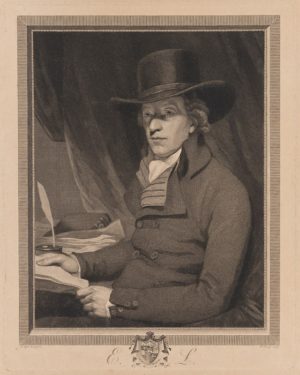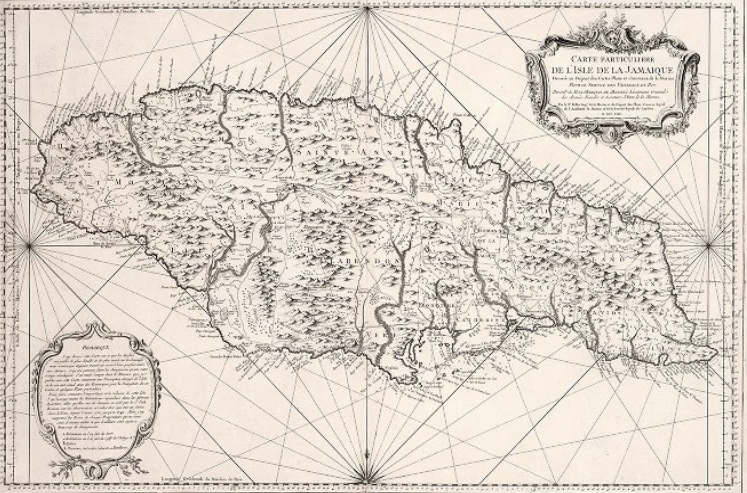The Jamaican Airs Exhibit
By: Devin Leigh (University of California, Davis)
What is “The Jamaican Airs?”
Welcome! “The Jamaican Airs” is an online and interactive museum exhibit. It is based around a chapter on Afro-Jamaican music from an unpublished manuscript. The manuscript was written by an anonymous author in the years leading up to 1776, and it was preserved in the personal papers of the Jamaican historian and slaveowner Edward Long at the British Library in London. Much of this chapter was originally published in the spring of 1797, in a periodical from Kingston, Jamaica, called The Columbian Magazine; or Monthly Miscellany. However, over half of the material featured here has never been published and has never been the subject of scholarly analysis. This half is important because it includes the most extensive pieces of musical notation for songs, or “airs”, from the early-modern period that were composed and performed by people of African descent. These are also the most extensive pieces of musical notation that survive from Jamaica—and perhaps the entire Caribbean—prior to the nineteenth century. They contain some of the earliest historical material on Jamaican subcultures, such as the “set girls” and “myal society.” (Image of Volume 2 of Edward Long’s annotated copy of The History of Jamaica in the British Library)

Who Wrote this Material?
The material featured here comes from two different authors. Most of it was written by an unidentified white man. What we know about him is that he was a slaveowner who lived in Jamaica between the early 1770s and the late 1790s; that he split his time between Kingston—the island’s commercial capital—and a plantation located in the eastern half of the parish St. Thomas in the Vale; that he was acquainted with London’s history and culture; and that he was almost certainly a musician and/or composer. This man collected the airs featured here in the early 1770s as part of an ethnographic work that he created through observing and interviewing members of the enslaved community. Although he never published that work, he sent chapters of it to Long, an historian he admired who was then living in England. Long preserved those chapters with the design of including them in a second edition of his three-volume masterwork, The History of Jamaica, originally published in 1774. That edition was also never published. Nonetheless, Long is the second author featured in this exhibit. His reading notes, which appear immediately after the Jamaican airs in his archive, are included here. These notes are principally derived from two sources: Long’s experience living in Jamaica between 1757 and 1769, and the first volume of A General History of Music, written by the English music historian Charles Burney in 1776. (Portrait of Edward Long by William Sharp, c. 1796, from the National Portrait Gallery, London.)

What Have Scholars Said About this Material?
As mentioned previously, some of the content featured here was published as an installment of a series in The Columbian Magazine. This series was excerpted and published in a limited release by Barry Higman in 1976. A few scholars—such as Edward Kamau Brathwaite, Michael Craton, Jackie Ranston, and Linda Sturtz—have used these materials to explore the nuances of Afro-Jamaican public culture and performance in the eighteenth century. Jamaica was the British Empire’s most populace, most profitable, and perhaps most brutal slave society in the eighteenth century. As such, these scholars have used this source to discuss how people of African descent employed culture to resist and cope with their enslavement. They have explored music as a medium of black self-expression, designed to counter the efforts of the white planter community to dominate enslaved people. They have also explored music as evidence of creolization. This is the historical process by which Afro-Jamaican culture emerged from the gradual blending of various African and European influences. These themes are also prominent in the larger historiography of Afro-Caribbean music and history. In particular, works by Jerome Handler, Charlotte J. Frisbie, Richard Cullen Rath, and Mary Caton Lingold have been influential to this project. Crucially, the pieces of musical notation are being published here for the first time. Hopefully, they will add to these ongoing conversations about Caribbean culture and history in the eighteenth century. (Image: Jacques-Nicolas Bellin, Carte Particuliere de L'Isle de la Jamaique, 1758, Paris.)
A Guide to the Exhibit
This exhibit showcases both images and transcriptions of the primary source. In the future, it may include interpretive recordings of the songs and taped performances. The exhibit begins with four pages that feature our anonymous author’s general thoughts on Afro-Jamaican music. Afterward, each of the Jamaican airs are displayed in the order that they appear in the unpublished manuscript chapter. There are three categories of airs, called by the author “Tunes in General Use,” “Airs Used by Distinct Sets,” and “African Music.” The first category includes five songs, the second category includes four songs, and the third category includes three songs. Many of the songs refer to specific aspects of Afro-Jamaican culture. In time, these will be explained in notes sections that are added to the individual pages. Next, the exhibit includes Long’s reading notes on African music, intended for the second edition of The History of Jamaica. Then comes the complete set of images for the source—the unpublished chapter and Long’s reading notes. This is followed by images of the corresponding material from The Columbian Magazine. Finally, the exhibit concludes with a bibliography for further reading and a working list of people who have contributed to the project.
Contributing to the Exhibit
This exhibit is part of a greater effort to share this music with people who are interested in exploring Caribbean history, society, and culture. It is designed to make these pieces of musical notation accessible to the widest possible audience and, in doing so, curate an open space for both scholars and non-scholars like to analyze them academically, artistically, and otherwise. Regardless of your experience or background, you can contribute to this exhibit by reaching out to the co-creators and sharing your impressions. What do you see when you look at these pieces of musical notation and their commentary? What do they mean to you as artifacts of music, history, and culture? Send us an email with your thoughts and any ideas you have for future projects. We will add your name to our updated contributors list and perhaps even incorporate your material into the exhibit.
Citing This Exhibit
Devin Leigh, “The Jamaican Airs Exhibit.” Early Caribbean Digital Archive. Northeastern University, 2019. ecda.northeastern.edu/Jamaican-music-exhibit-leigh/. Accessed [date].
Want to learn even more? Check out Leigh's article in Atlantic Studies
In Fall of 2019 Leigh published "The Jamaican airs: An Introduction to Unpublished Pieces of Musical Notation from Enslaved People in the Eighteenth-Century Caribbean" in Atlantic Studies. This exhibit acts as a companion to the work, that expands his article by providing further context to the Airs.

